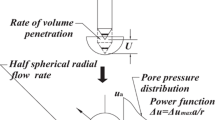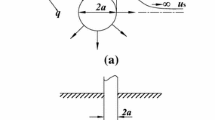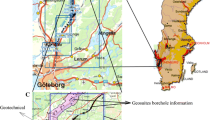Abstract
The piezocone penetration test (CPTU) is widely used to estimate the soil properties, in geotechnical engineering. This study focuses on the developed graphical assessment method through existing CPTU-based Ic–k (soil behavior index-hydraulic conductivity) correlations and a proposed new one. Frequency curve graph is extended to the differences of different curves more clearly, by comparing downward trend of curves, calculating areas and introducing derived novel area indexes. The combination of the clarity of frequency curve graphs and the derivative indexes will ensure the suitability and accuracy, especially for engineers. The results of the traditional statistical index and the developed graphic assessment show that the proposed correlations show better performance. Hence, the proposed method could be further applied to different engineering fields.









Similar content being viewed by others
References
Anbazhagan P, Bajaj K, Reddy GR, Phanikanth VS, Yadav DN (2016) Quantitative assessment of shear wave velocity correlations in the shallow bedrock sites. Indian Geotech J 46(4):381–397. https://doi.org/10.1007/s40098-016-0181-y
Baligh MM, Levadoux JN (1980) Pore pressure dissipation after cone penetration. Massachusetts Institute of Technology, Department of Civil Engineering, Cambridge, Mass Report, pp R80–R110
Briaud J, Tucker LM (1988) Measured and predicted axial response of 98 piles. J Geotech 114(9):984–1001
Burns SE, Mayne PW (1998) Monotonic and dilatory pore pressure decay during piezocone tests in clay. Can Geotech J 35(6):1063–1073
Cai GJ (2010) Study on theory and engineering application of digital multifunctional piezocone penetration test (CPTU) (in Chinese). Ph. D dissertation, School of Transportation, Southeast University, China
Cai GJ, Puppala AJ, Liu SY (2014) Characterization on the correlation between shear wave velocity and piezocone tip resistance of Jiangsu clays. Eng Geol 171:96–103. https://doi.org/10.1016/j.enggeo.2013.12.012
Cai GJ, Liu SY, Puppala AJ (2015) Consolidation parameters interpretation of CPTU dissipation data based on strain path theory for soft jiangsu quaternary clays. Mar Georesour Geotechnol 33(4):310–319
Cetin KO, Ozan NS (2009) CPT-based probabilistic soil characterization and classification. J Geotech Geoenviron 135(1):84–107
Chai JC, Agung PMA, Hino T et al (2011) Estimating hydraulic conductivity from piezocone soundings. Geotechnique. 61(8):699–708
Cherubini C, Orr TLL (2000) A rational procedure for comparing measured and calculated values in geotechnics. Coastal Geotech Eng Practice, Yokohama 1:261–265
Danziger FAB, Almeida MSS, Sills GC (1997) The significance of the strain path analysis in the interpretation of piezocone dissipation data. Geotechnique. 47(5):901–914. https://doi.org/10.1680/geot.1997.47.5.901
Elsworth D, Lee DS (2005) Permeability determination from on-thefly piezocone sounding. J Geotech Geoenviron 131(5):643–653
Elsworth D, Lee DS (2007) Limits in determining permeability from on-the-fly uCPT sounding. Geotechnique. 57(8):679–685. https://doi.org/10.1680/geot.2007.57.8.679
Fan N, Jiang JX, Dong YK, Guo L, Song LF (2022) Approach for evaluating instantaneous impact forces during submarine slide-pipeline interaction considering the inertial action. Ocean Eng 245:110466
Grima MA, Babuška R (1999) Fuzzy model for the prediction of unconfined compressive strength of rock samples. Int J Rock Mech Min Sci 36(3):339–349. https://www.sciencedirect.com/science/article/abs/pii/S0148906299000078
Jaeger RA (2012) Numerical and experimental study on cone penetration in sands and intermediate soils. Ph.D dissertation, University of California, Davis
Jefferies MG, Davies MP (1993) Use of CPTU to estimate equivalent SPT N60. Geotech Test J 16(4):458–468
Kulhawy, F.H., Mayne, P.W., 1990. Manual on estimating soil properties for foundation design. electric power research institute.
Lunne T, Robertson PK, Powell JJM (1997) Cone penetration testing in geotechnical practice. CRC Press, Washington
Maheswari RU, Boominathan A, Dodagoudar GR (2010) Use of surface waves in statistical correlations of shear wave velocity and penetration resistance of Chennai soils. Geotech Geol Eng 28(2):119–137. https://doi.org/10.1007/s10706-009-9285-9.pdf
Manassero M (1994) Hydraulic conductivity assessment of slurry wall using piezocone test. J Geotech 120(10):1725–1746
Onyejekwe S, Kang X, Ge L (2015) Assessment of empirical equations for the compression index of fine-grained soils in Missouri. Bull Eng Geol Environ 74(3):705–716. https://doi.org/10.1007/s10064-014-0659-8
Parez L, Fauriel R (1988) Le piezocone ameliorations apportees a la reconnaissance de sols. Rev Fr Géotech 44(44):13–27 (in French)
Robertson PK (1990) Soil classification using the cone penetration test. Can Geotech J 27(1):151–158. https://doi.org/10.1139/t90-014
Robertson PK (2009) Estimating in-situ soil permeability from CPT & CPTu. Can Geotech J 46(1):442–447
Robertson PK, Wride CE (1998) Evaluating cyclic liquefaction potential using the cone penetration test. Can Geotech J 35(3):442–459
Robertson PK, Campanella RG, Gillespie D, Greig J (1986) Use of piezometer cone data. In: In-situ’86 use of in-situ testing in geotechnical engineering. ASCE, Blacksburg, pp 1263–1280
Robertson PK, Sully JP, Woeller DJ et al (1992) Estimating coefficient of consolidation from piezocone test. Can Geotech J 29(4):539–550. https://doi.org/10.1139/t92-061
Satvati S, Alimohammadi H, Rowshanzamir M, Hejazi SM (2020) Bearing capacity of shallow footings reinforced with braid and geogrid adjacent to soil slope. Int J Geosyn Ground Eng 6:41. https://doi.org/10.1007/s40891-020-00226-x
Shen SL, Han J, Huang XC, Du SJ (2003) Laboratory studies on property changes in surrounding clays due to installation of deep mixing columns. Mar Georesour Geotechnol 21(1):15–35. https://doi.org/10.1080/10641190306711
Sully JP, Robertson PK, Campanella RG, Woeller DJ (1999) An approach to evaluation of field CPTU dissipation data in overconsolidated fine-grained soils. Can Geotech J 36(2):369–381. https://doi.org/10.1139/t98-105
Takai A, Inui T, Katsumi T (2016) Evaluating the hydraulic barrier performance of soil-bentonite cutoff walls using the piezocone penetration test. Soils Found 56(2):277–290. https://doi.org/10.1016/j.sandf.2016.02.010
Wang JP, Xu YS, Ma L, Shen SL (2013) An approach to evaluate hydraulic conductivity of soil based on CPTU test. Mar Georesour Geotechnol 31(3):242–253. https://doi.org/10.1080/1064119X.2012.676154
Yang YJ (2015) Study on design parameters for deep foundation based on CPTU test (in Chinese). MSC thesis, School of Transportation, Southeast University, China
Zeng LL, Hong ZS, Cai YQ, Han J (2011) Change of hydraulic conductivity during compression of undisturbed and remolded clays. Appl Clay Sci 51(1):86–93. https://doi.org/10.1016/j.clay.2010.11.005
Zhang MF, Tong LY (2017) New statistical and graphical assessment of CPT-based empirical correlations for the shear wave velocity of soils. Eng Geol 226:184–191. https://doi.org/10.1016/j.enggeo.2017.06.007
Zhang MF, Tong LY, Yang YJ, Che HN, Pan HS (2018) In situ determination of hydraulic conductivity in Yangtze Delta deposits using a modified piezocone model. Bull Eng Geol Environ 77:153–164. https://doi.org/10.1007/s10064-016-0968-1
Zheng J, He H, Alimohammadi H (2021a) Three-dimensional wadell roundness for particle angularity characterization of granular soils. Acta Geotech 16:133–149. https://doi.org/10.1007/s11440-020-01004-9
Zheng G, Alimohammadi H, Zheng J, Schaefer VR (2021b) Effectiveness of geosynthetics in the construction of roadways: a full-scale field studies review. Int Found Congress Equip Exp. https://doi.org/10.1061/9780784483411.022
Zou HF, Cai GJ, Liu SY (2014) Evaluation of coefficient of permeability of saturated soils based on CPTU dislocation theory. Chin J Geotech Eng 36(3):519–528 (in Chinese)
Funding
The financial support is from the National Natural Science Foundation of China (Grant Nos. 41902266 and 51878157) and Key R&D and Promotion Projects in Henan Province (tackling key problems in science and technology) (Grant Nos. 212102310275, 202102310240, 202102310572, 212102310967, and 212102310968), Training plan for young backbone teachers in Colleges and universities of Henan Province (2021GGJS116), 2022 science and technology R & D plan of China Railway Construction Group Co., Ltd (22-76D); and Youth Elite Scientists Sponsorship Program by Henan Association for Science and Technology (2022HYTP011).
Author information
Authors and Affiliations
Corresponding author
Ethics declarations
Conflict of interest
The authors declare no competing interests.
Additional information
Responsible editor: Zeynal Abiddin Erguler
Rights and permissions
About this article
Cite this article
Zhang, M., Tong, L. A new graphical approach to assess CPTU-based correlations between hydraulic conductivity and soil behavior type. Arab J Geosci 15, 1115 (2022). https://doi.org/10.1007/s12517-022-10357-2
Received:
Accepted:
Published:
DOI: https://doi.org/10.1007/s12517-022-10357-2




